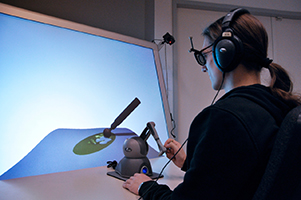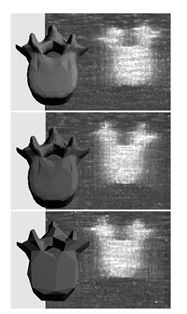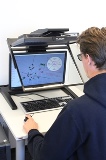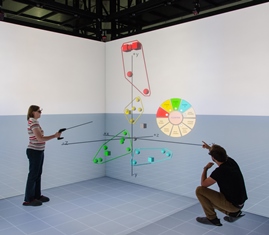Publications
Comparing Auditory and Haptic Feedback for a Virtual Drilling Task

While visual feedback is dominant in Virtual Environments, the use of other modalities like haptics and acoustics can enhance believability, immersion, and interaction performance. Haptic feedback is especially helpful for many interaction tasks like working with medical or precision tools. However, unlike visual and auditory feedback, haptic reproduction is often difficult to achieve due to hardware limitations. This article describes a user study to examine how auditory feedback can be used to substitute haptic feedback when interacting with a vibrating tool. Participants remove some target material with a round-headed drill while avoiding damage to the underlying surface. In the experiment, varying combinations of surface force feedback, vibration feedback, and auditory feedback are used. We describe the design of the user study and present the results, which show that auditory feedback can compensate the lack of haptic feedback.
@inproceedings {EGVE:JVRC12:049-056,
booktitle = {Joint Virtual Reality Conference of ICAT - EGVE - EuroVR},
editor = {Ronan Boulic and Carolina Cruz-Neira and Kiyoshi Kiyokawa and David Roberts},
title = {{Comparing Auditory and Haptic Feedback for a Virtual Drilling Task}},
author = {Rausch, Dominik and Aspöck, Lukas and Knott, Thomas and Pelzer, Sönke and Vorländer, Michael and Kuhlen, Torsten},
year = {2012},
publisher = {The Eurographics Association},
ISSN = {1727-530X},
ISBN = {978-3-905674-40-8},
DOI = {10.2312/EGVE/JVRC12/049-056}
pages= { -- }
}
Geometrical-Acoustics-based Ultrasound Image Simulation

Brightness modulation (B-Mode) ultrasound (US) images are used to visualize internal body structures during diagnostic and invasive procedures, such as needle insertion for Regional Anesthesia. Due to patient availability and health risks-during invasive procedures-training is often limited, thus, medical training simulators become a viable solution to the problem. Simulation of ultrasound images for medical training requires not only an acceptable level of realism but also interactive rendering times in order to be effective. To address these challenges, we present a generative method for simulating B-Mode ultrasound images using surface representations of the body structures and geometrical acoustics to model sound propagation and its interaction within soft tissue. Furthermore, physical models for backscattered, reflected and transmitted energies as well as for the beam profile are used in order to improve realism. Through the proposed methodology we are able to simulate, in real-time, plausible view- and depth-dependent visual artifacts that are characteristic in B-Mode US images, achieving both, realism and interactivity.
Poster: VisNEST - Interactive Analysis of Neural Activity Data

Modeling and simulating a brain’s connectivity produces an immense
amount of data, which has to be analyzed in a timely fashion.
Neuroscientists are currently modeling parts of the brain –
e.g. the visual cortex – of primates like Macaque monkeys in order
to deduce functionality and transfer newly gained insights to
the human brain. Current research leverages the power of today’s
High Performance Computing (HPC) machines in order to simulate
low level neural activity. In this paper, we describe an interactive
analysis tool that enables neuroscientists to visualize the resulting
simulation output. One of the driving challenges behind our development
is the integration of macroscopic data, e.g. brain areas, with
microscopic simulation results, e.g. spiking behavior of individual neurons.
Honorable Mention!
CAVIR: Correspondence Analysis in Virtual Reality. Ways to a Valid Interpretation of Correspondence Analytical Point Clouds in Virtual Environments

Correspondence Analysis (CA) is frequently used to interpret correlations between categorical variables in the area of market research. To do so, coherences of variables are converted to a three-dimensional point cloud and plotted as three different 2D-mappings. The major challenge is to correctly interpret these plottings. Due to a missing axis, distances can easily be under- or overestimated. This can lead to a misclustering and misinterpretation of data and thus to faulty conclusions. To address this problem we present CAVIR, an approach for CA in Virtual Reality. It supports users with a virtual three-dimensional representation of the point cloud and different options to show additional information, to measure Euclidean distances, and to cluster points. Besides, the free rotation of the entire point cloud enables the CA user to always have a correct view of the data.
@Article{Graff2012,
Title = {{CAVIR}: {C}orrespondence {A}nalysis in {V}irtual {R}eality. {W}ays to a {V}alid {I}nterpretation of {C}orrespondence {A}nalytical {P}oint {C}louds in {V}irtual {E}nvironments},
Author = {Frederik Graff and Andrea B\"{o}nsch and Daniel B\"{u}ndgens and Torsten Kuhlen},
Journal = {{C}onference {P}roceedings: {I}nternational {M}asaryk {C}onference for {P}h.{D}. {S}tudents and {Y}oung {R}esearchers},
Year = {2012},
Pages = {653-662},
Volume = {3},
Url = {http://www.vedeckekonference.cz/library/proceedings/mmk_2012.pdf}
}
CAVIR: Correspondence Analysis in Virtual Reality

Correspondence Analysis (CA) is used to interpret correlations between categorical variables in the areas of social science and market research. To do so, coherences of variables are converted to a three-dimensional point cloud and plotted as several different 2D-mappings, each containing two axes. The major challenge is to correctly interpret these plottings. Due to a missing axis, distances can easily be under- or overestimated. This can lead to a misinterpretation and thus a misclustering of data.
To address this problem we present CAVIR, an approach for CA in Virtual Reality. It supports users with a three-dimensional representation of the point cloud and different options to show additional information, to measure Euclidean distances, and to cluster points. Besides, the motion parallax and a free rotation of the entire point cloud enable the CA expert to always have a correct view of the data.
Best Presentation Award!
@Article{Boensch2012,
Title = {{CAVIR}: {C}orrespondence {A}nalysis in {V}irtual {R}eality},
Author = {Andrea B\"{o}nsch and Frederik Graff and Daniel B\"{u}ndgens and Torsten Kuhlen},
Journal = {{V}irtuelle und {E}rweiterte {R}ealit\"at, 9. {W}orkshop der {GI}-{F}achgruppe {VR}/{AR}},
Year = {2012},
Pages = {49-60},
ISSN = {978-3-8440-1309-2}
Publisher = {Shaker Verlag},
}
Previous Year (2011)

